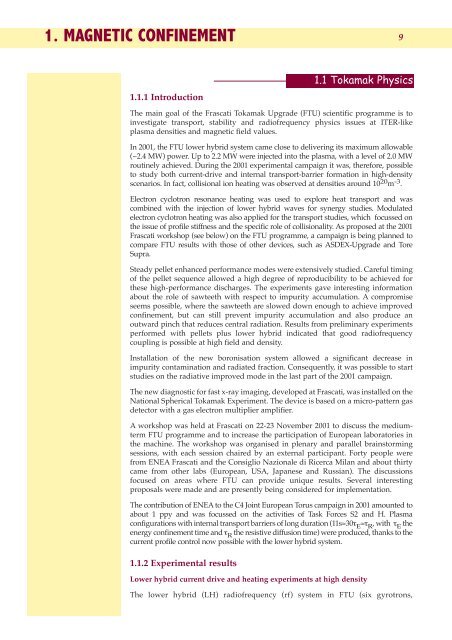1. magnetic confinement - ENEA - Fusione
1. magnetic confinement - ENEA - Fusione
1. magnetic confinement - ENEA - Fusione
Create successful ePaper yourself
Turn your PDF publications into a flip-book with our unique Google optimized e-Paper software.
<strong>1.</strong> MAGNETIC CONFINEMENT<br />
9<br />
<strong>1.</strong><strong>1.</strong>1 Introduction<br />
<strong>1.</strong>1 Tokamak Physics<br />
The main goal of the Frascati Tokamak Upgrade (FTU) scientific programme is to<br />
investigate transport, stability and radiofrequency physics issues at ITER-like<br />
plasma densities and <strong>magnetic</strong> field values.<br />
In 2001, the FTU lower hybrid system came close to delivering its maximum allowable<br />
(~2.4 MW) power. Up to 2.2 MW were injected into the plasma, with a level of 2.0 MW<br />
routinely achieved. During the 2001 experimental campaign it was, therefore, possible<br />
to study both current-drive and internal transport-barrier formation in high-density<br />
scenarios. In fact, collisional ion heating was observed at densities around 10 20 m -3 .<br />
Electron cyclotron resonance heating was used to explore heat transport and was<br />
combined with the injection of lower hybrid waves for synergy studies. Modulated<br />
electron cyclotron heating was also applied for the transport studies, which focussed on<br />
the issue of profile stiffness and the specific role of collisionality. As proposed at the 2001<br />
Frascati workshop (see below) on the FTU programme, a campaign is being planned to<br />
compare FTU results with those of other devices, such as ASDEX-Upgrade and Tore<br />
Supra.<br />
Steady pellet enhanced performance modes were extensively studied. Careful timing<br />
of the pellet sequence allowed a high degree of reproducibility to be achieved for<br />
these high-performance discharges. The experiments gave interesting information<br />
about the role of sawteeth with respect to impurity accumulation. A compromise<br />
seems possible, where the sawteeth are slowed down enough to achieve improved<br />
<strong>confinement</strong>, but can still prevent impurity accumulation and also produce an<br />
outward pinch that reduces central radiation. Results from preliminary experiments<br />
performed with pellets plus lower hybrid indicated that good radiofrequency<br />
coupling is possible at high field and density.<br />
Installation of the new boronisation system allowed a significant decrease in<br />
impurity contamination and radiated fraction. Consequently, it was possible to start<br />
studies on the radiative improved mode in the last part of the 2001 campaign.<br />
The new diagnostic for fast x-ray imaging, developed at Frascati, was installed on the<br />
National Spherical Tokamak Experiment. The device is based on a micro-pattern gas<br />
detector with a gas electron multiplier amplifier.<br />
A workshop was held at Frascati on 22-23 November 2001 to discuss the mediumterm<br />
FTU programme and to increase the participation of European laboratories in<br />
the machine. The workshop was organised in plenary and parallel brainstorming<br />
sessions, with each session chaired by an external participant. Forty people were<br />
from <strong>ENEA</strong> Frascati and the Consiglio Nazionale di Ricerca Milan and about thirty<br />
came from other labs (European, USA, Japanese and Russian). The discussions<br />
focused on areas where FTU can provide unique results. Several interesting<br />
proposals were made and are presently being considered for implementation.<br />
The contribution of <strong>ENEA</strong> to the C4 Joint European Torus campaign in 2001 amounted to<br />
about 1 ppy and was focussed on the activities of Task Forces S2 and H. Plasma<br />
configurations with internal transport barriers of long duration (11s≈30τ E ≈τ R , with τ E the<br />
energy <strong>confinement</strong> time and τ R the resistive diffusion time) were produced, thanks to the<br />
current profile control now possible with the lower hybrid system.<br />
<strong>1.</strong><strong>1.</strong>2 Experimental results<br />
Lower hybrid current drive and heating experiments at high density<br />
The lower hybrid (LH) radiofrequency (rf) system in FTU (six gyrotrons,













